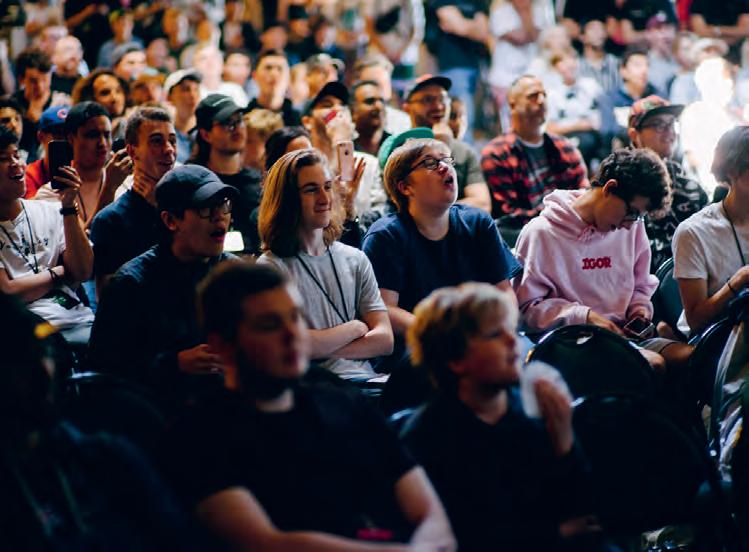
6 minute read
DECK, TECH
How cardistry evolved as an artform
by Kevin Ho
The evolution of cardistry throughout the years has advanced in direct correlation with the progression of technology in the real world.
Let’s flash back to the beginning. In ye’ olden days, the only way to learn a move was from a teacher in real life, should one be lucky enough to have the opportunity. Picture an apprentice waiting in the pouring rain outside a master’s abode for days before being granted access to the inner secrets of the Charlier Cut, and you get the idea. Because of this oral tradition, the spread of card handling methods was few and far between.
With the advent of the printing press, people had an avenue to record the methodology of cardistry for posterity. With illustrations and descriptive text, publications like The Expert at the Card Table allowed interested parties to learn moves without the presence of an in-person teacher. This form of instruction continues with works such as Jerry Cestkowski’s Encyclopedia of Playing Card Flourishes, and such instances as the booklets by the Danes.

In the late 20th century, home video became an accessible medium for recording flourishes, and as such, we had notable releases such as Brian Tudor’s Show Off and Dan and Dave Buck’s Pasteboard Animations that not only taught moves, but also showed the viewers what those moves looked like. No longer restricted to having to imagine what a move looked like from interpreting it from the page, the average enthusiast now had examples to follow directly along with. This also helped spread the art of cardistry, as people who had no idea what it was before had the chance to be impressed and inspired by performances without having to see the art form being performed live in person.
Later, DVDs became the medium of choice, with Dan and Dave Buck’s The System and The Trilogy being standout examples. This continued until the death of physical home media down the line due to on-demand videos and free tutorials.
Another invention of the late 20th century, the internet, was also responsible for a major advancement in cardistry. As one can surmise from the previous paragraphs, being able to discover cardistry prior to the internet could be quite rare: either through seeing a live demonstration or by stumbling on a book/VHS/ DVD in a magic store or catalog. With the internet, one could stumble across cardistry on niche websites such as Cheaters Cheater or Superhandz, with each even hosting tutorials with varying degrees of access depending on the user’s status on these message boards.
The internet continued to provide another significant avenue for cardistry-sharing in the form of 2005’s viral sensation, YouTube. Before YouTube, uploading and sharing videos was limited to either self-hosting on one’s own platform (which required rudimentary web hosting knowledge), or being at the whim of a message board’s own video hosting system, which could be limited to the limitations, rules, and scope of said website. After YouTube, someone who wanted to share a performance or a tutorial could simply do so with the click of a few buttons, and easily share the link to their creation with others via instant messaging, forums, or by embedding them on websites. YouTube’s algorithm (which continues to evolve and improve) also allows for the odd upload to find its way to the average non-cardist, thereby introducing them to the art form in a serendipitous fashion. Cardists such as Virtuoso and Zach Mueller have achieved astounding viral success with the platform, racking up millions of views each.
Refocusing back inwards for a moment, there was another movement that allowed for a notable advancement within the online cardistry community: video chatting. A lot of cardistry-sharing before this mainly happened after the fact: someone would post a message or a video, people would respond to it, and the cycle would continue. With video chatting, cardists could come together one-on-one on services such as Skype, or in groups through platforms such as MeBeam and Tinychat, to jam together and share material they were working on. Jams were nothing new, of course - by that time, countries like Singapore had sizable cardistry communities that met on a regular basis to jam - but with video chatting, cardists from the world over were no longer restricted by geography or time zones, and could hop on to the web at any time to hang out with friends that shared the same interest as them. And although services like Skype, MeBeam, and Tinychat have either dropped in popularity or gone the way of the dinosaur by now, video chatting as a way of jamming continues to live on in places such as Discord, where multiple servers exist that cardists can gather together in real time to jam.
Mobile phones became popular in the late 20th century as well, but it was the advent of smartphones such as the iPhone in 2007 that really changed the game for cardistry. Video production could prove complicated for the neophyte: for example, with miniDV, one had to buy a miniDV tape, set the camera up on a tripod, record the footage, make sure one had FireWire installed on their computer, plug the camera in, import said miniDV footage, edit it with a program such as Windows Movie Maker or iMovie, export the footage, and then upload it on YouTube. Smartphones cut out a majority of the steps in between conception and completion: with a smartphone, one could record something like a one-handed cut in one hand while the other hand was filming, and a few buttons later it could be on YouTube.
In 2010, Instagram came along and became the new watering hole for cardistry. Previously, cardists had to rely on websites like TheCuso.info, Kardistry.com, or the occasional YouTube subscription for new content.



